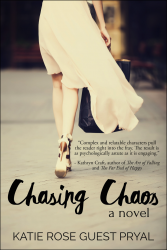Guest Post: Writing Around Your Dialogue by Author Katie Rose Guest Pryal
Today we’re talking about dialogue (HA) here on WFW with my fellow Tall Poppy Writer Katie Rose Guest Pryal. We all love to read great dialogue, and though we all write differently, there are pitfalls we can all avoid! Here’s how Katie tackles the dialogue in her novels!
Remember, when it comes to writing advice, please take what what you need and leave the rest.
Welcome Katie to WFW and leave your dialogue tips in the comments!
Amy xo

Framing Text: How To Write Well Around Your Dialogue
by Katie Rose Guest Pryal
 Many authors lament writing dialogue. So many things about dialogue seem too challenging:
Many authors lament writing dialogue. So many things about dialogue seem too challenging:
Making it sound how real people talk
Conveying character through snippets of speech
Making sure each character sounds unique
Conveying action while people are talking
Ensuring that a reader understands who is speaking during a conversation
and more.
I’m very lucky. On a whim, in college, I took a screenwriting class. That class was the best thing to ever happen to my fiction. I learned how to write dialogue, dialogue that conveyed unique character traits, action, realism, and all of the other things that make writing dialogue so difficult. After all, a screenplay consists almost 100% of dialogue. If your dialogue sucks, your screenplay sucks.
I’m not saying I write the greatest dialogue. I’m only saying that the screenwriting class gave me confidence to try to tell stories through conversation. And as most writers know, confidence goes a long, long way.
But, in the short space I have here, I’m not going to talk about writing dialogue. I’m going to talk about the writing that goes around your dialogue.
Framing Your Dialogue
The writing that goes on around your dialogue, what I (and likely others) call the “framing” text, is arguably as important as the dialogue itself. But many writers give it short shrift.
Framing text never appeared in my screenplays, and I had to study really hard to learn to write it well when I made the leap from scripts to novels.
The most common framing text consists of a noun or pronoun plus the word “said,” like this:
“Dialogue,” she said.
But there are problems with using “said” to frame all of our dialogue. First, it’s really boring. You are basically using the same word over and over again, and the repetition gets old. Second, and worse, you are wasting opportunities. Instead of “said,” you could be using that framing text to convey what the speaker is doing or thinking.
Your framing text can also make sure your reader knows who is talking to whom, how your speaker feels about what is being said, and what else is going on during the conversation. If you limit yourself to the word “said,” then you aren’t giving yourself enough room to do all those things that need doing.
This isn’t to say that you shouldn’t ever use the word “said” in your writing. You can, and should, most certainly. But challenge yourself to write entire scenes without it. See what happens. Only resort to “said” if you have to.
An Example of Dialogue Framing Text without “Said”
Here’s a sample scene from a novel I’m working on now, the sequel to Chasing Chaos (which just came out in June). The only setup I’m going to give you is this: two characters, Miranda and Sandy, have just entered an exclusive Los Angeles restaurant. The rest—setting, characterization—you’ll have to get from the dialogue and its framing text. I’ll interject in brackets to point things out.
[begin scene]
The host approached them, a young man, certainly younger than Miranda’s twenty-eight years. He was in his early twenties, perhaps his late teens. His dark suit was well tailored, though, and well made.
[The above paragraph should alert you that we are in Miranda’s point of view.]
“Jonas.” Sandy greeted the host, then he nodded at Miranda. “This is Miranda George, an old friend of Greta Donovan and Daphne Saito. She just moved to L.A. Been here about a week.”
[Notice how Sandy’s framing text does not use the word “said.” The framing text also conveys the physical gestures that Sandy makes so we can picture what he’s doing, e.g., nodding.]
Miranda thought it was a stretch to call her an “old friend” of either Daphne or Greta, but she wasn’t going to correct Sandy.
“It’s great to meet you, Miss George.” Jonas smiled, revealing either the most lucky dental genetics ever, or at least ten grand in orthodontia.
[Again, the word “said” isn’t used to indicate Jonas’s speech. This framing text was also an opportunity to reveal more about Miranda’s character. You will see that she is a bit snarky.]
She figured it was the latter. “Please just call me Miranda.”
“That’s what Mr. Sandy always says.” Jonas flushed a deep scarlet. “I mean, Sandy.”
[Here if we haven’t figured out that Jonas is very young, goofy, and adorable, then I basically need to give him pimples.]
“It’s all right, Jonas.” Sandy smiled kindly. “Our table ready?”
Miranda was certain that Sandy’s table was always ready, considering he owned not only the restaurant but also two Academy Awards for Best Actor.
[In the framing text of the above two paragraphs, we learned two things. One, Sandy is a nice guy, and two, Sandy is rich as hell.]
Jonas grabbed two thick leather menus from a stand by the door. “Follow me, sir.”
“After you.” Sandy held out his hand for Miranda to take the lead. When she didn’t step forward immediately, he chuckled. “Don’t like having people at your back?”
[Here, Sandy is showing a little snark of his own. It makes us like him better.]
“It’s fun to follow you. I get to watch idiots trip over themselves when they see who you are.”
Sandy paused, looking at her thoughtfully. “You don’t think highly of other people.”
[Aha. Sandy is insightful. This insight has an effect on Miranda in 3, 2, 1…]
“I’m selective.” As a rule, Miranda indeed didn’t think highly of other people. But she wasn’t going to tell Sandy that. Her misanthropy was not her most charming feature.
[And here we have insight into Miranda. She’s snarky but also cares what Sandy thinks of her. Interesting.]
“Where do I fall?” Sandy surprised her by sounding genuinely curious, even concerned.
[Sandy cares what Miranda thinks? But why? Don’t you totally want to keep reading?]
She smiled, trying to lighten a conversation that had grown darker than she’d planned it to. “I’ll let you know after I’ve bought you a drink.”
“You’re buying?” He sounded surprised. Good.
“In a manner of speaking.” Miranda still had the credit card she’d taken from her mother’s wallet.
Sandy laughed. “After me, then.”
[end scene]
As you can see from this brief demonstration, the language that you put around your dialogue can be just as important as the language that you put in your dialogue. It can convey scene, character, plot (what’s up with that stolen credit card?), and more. Be sure you give it as much thought as it deserves.
 Katie Rose Guest Pryal, J.D., Ph.D., is a novelist, freelance journalist, and erstwhile law professor in Chapel Hill, NC. She is the author of the Entanglement Series, which includes ENTANGLEMENT, LOVE AND ENTROPY, and CHASING CHAOS, all from Velvet Morning Press. As a journalist, Katie contributes regularly to QUARTZ, THE CHRONICLE OF HIGHER EDUCATION, THE (late, lamented) TOAST, DAME MAGAZINE, and more. She earned her master’s degree in creative writing from the Writing Seminars at Johns Hopkins, where she attended on a fellowship. Currently, she is teaching creative writing through Duke University’s Osher Lifelong Learning Institute, working as a writing coach and editor, and writing her next novels.
Katie Rose Guest Pryal, J.D., Ph.D., is a novelist, freelance journalist, and erstwhile law professor in Chapel Hill, NC. She is the author of the Entanglement Series, which includes ENTANGLEMENT, LOVE AND ENTROPY, and CHASING CHAOS, all from Velvet Morning Press. As a journalist, Katie contributes regularly to QUARTZ, THE CHRONICLE OF HIGHER EDUCATION, THE (late, lamented) TOAST, DAME MAGAZINE, and more. She earned her master’s degree in creative writing from the Writing Seminars at Johns Hopkins, where she attended on a fellowship. Currently, she is teaching creative writing through Duke University’s Osher Lifelong Learning Institute, working as a writing coach and editor, and writing her next novels.
web: http://katieroseguestpryal.com
books: http://amzn.to/1XFCLYS
twitter: http://twitter.com/krgpryal

Women's Fiction Writers
- Amy Sue Nathan's profile
- 543 followers



